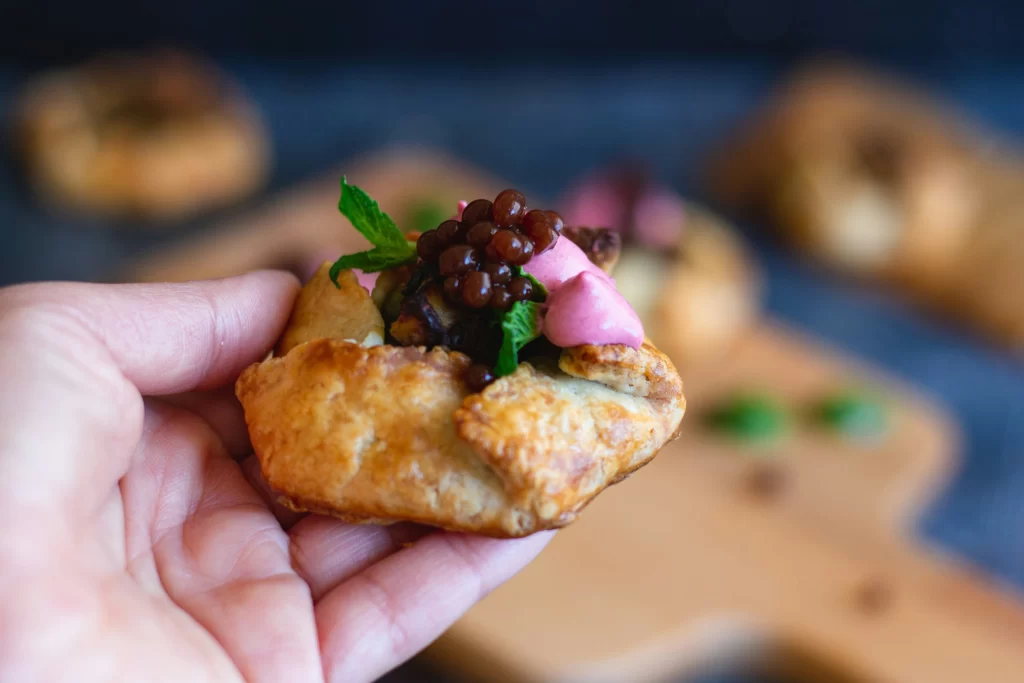Introduction
Who can resist the charm of a perfectly crafted pastelito? These little pockets of heaven are a staple in Hispanic cuisine, known for their delightful fillings and exquisite outer layers. Whether you call them pastelitos or empanadas, these savory treats are a must-have addition to any appetizer table. In this blog post, we’ll explore the world of pastelitos, diving into their history, variety, and how you can make your own at home. Prepare to be enchanted by these crispy, flaky, and utterly delicious creations!
The History of Pastelitos
Origins of a Culinary Delight
Pastelitos have deep roots in Hispanic culture, with a history that dates back centuries. Originating in Spain, these tasty treats were brought to the Americas by Spanish colonizers. Over time, they evolved into various forms, influenced by the local ingredients and culinary traditions of each region.
A Staple Across Latin America
Today, pastelitos are enjoyed throughout Latin America, from the bustling streets of the Dominican Republic to the cozy kitchens of Cuban households. Each country has its own unique take on pastelito, reflecting its distinct cultural and culinary heritage.
Pastelitos and Empanadas: What’s the Difference?
While pastelitos and empanadas are often used interchangeably, there are subtle differences between the two. Typically, pastelitos are fried and feature a crispy shell, while empanadas are often baked and made with puff pastry dough. Despite these differences, both are beloved for their versatility and mouth-watering flavor.
The Magic of the Outer Layer
The Perfect Dough
The outer layer of a pastelito is what sets it apart from other pastries. Made from a simple dough of flour, water, and fat, the magic lies in how the dough is prepared and cooked. It’s rolled out thin, filled with a savory or sweet filling, and then carefully folded and sealed before frying.
Achieving the Perfect Crispiness
A key characteristic of pastelitos is their crispy, flaky exterior. This is achieved by frying the dough until it reaches a golden-brown perfection. The result is a delightful contrast between the crunchy shell and the soft, flavorful filling inside.
A Feast for the Senses
The outer layer of a pastelito isn’t just about texture; it also enhances the overall sensory experience. The enticing aroma of fried dough, the satisfying crunch with each bite, and the visual appeal of golden-brown pastries make pastelitos a feast for all senses.
Delicious Fillings to Savor
Savory Sensations
Savory pastelitos are a favorite among many, with fillings ranging from seasoned meats to cheese and vegetables. Some popular savory fillings include:
- Picadillo: A classic ground beef mixture with olives, raisins, and spices.
- Chicken: Tender, shredded chicken seasoned with herbs and spices.
- Cheese: Melted cheese combined with herbs or vegetables for added flavor.
Sweet Temptations
But pastelitos aren’t just for savory lovers; they can also be filled with sweet ingredients, making them a versatile treat. Some delectable sweet fillings include:
- Guava and Cheese: A sweet and tangy combination of guava paste and cream cheese.
- Dulce de Leche: Creamy caramel filling that’s rich and indulgent.
- Fruit Preserves: Various fruit fillings, such as apple or pineapple, for a fruity twist.
Mix and Match
One of the joys of making pastelitos is the ability to mix and match fillings to suit your taste. Whether you prefer savory, sweet, or a combination of both, there’s a pastelito filling for everyone.
Pastelitos for Every Occasion
Breakfast Delight
In many parts of the Dominican Republic, pastelitos are a popular breakfast choice. Workers grab these on the go to fuel themselves for a day’s work. The combination of a hearty filling and a crispy shell makes for a satisfying and portable meal.
Appetizer Elegance
Pastelitos are a hit at family functions and holiday gatherings. Their bite-sized nature makes them perfect appetizers, and they’re often the first to disappear from the table. Guests love the variety of fillings and the excitement of biting into these little pockets of heaven.
Late-Night Snack
In urban areas, pastelitos are commonly sold by street vendors, especially after a late night out. There’s nothing quite like grabbing a fresh, hot pastelito to cap off an evening on the town. The satisfying crunch and savory filling are the perfect end to a fun night.
Making Pastelitos at Home
Ingredients You’ll Need
To make pastelitose at home, you’ll need a few basic ingredients for the dough and your choice of fillings. Here’s a simple list to get you started:
- Dough: Flour, water, salt, and fat (such as butter or lard).
- Fillings: Ground beef, chicken, cheese, guava paste, dulce de leche, or fruit preserves.
Step-by-Step Instructions
- Prepare the Dough: Mix flour, water, salt, and fat to form a dough. Knead until smooth and let it rest for 30 minutes.
- Roll Out the Dough: Roll the dough into thin circles, about 4-5 inches in diameter.
- Add Fillings: Place a spoonful of your chosen filling in the center of each dough circle.
- Fold and Seal: Fold the dough over the filling to form a half-moon shape. Press the edges firmly to seal.
- Fry to Perfection: Heat oil in a pan and fry the pastelitos until golden brown and crispy.
- Enjoy: Let them cool slightly before enjoying your homemade pastelitos.
Tips for Success
- Don’t Overfill: Be careful not to overfill the pastelitos, as this can cause them to burst during frying.
- Seal Well: Ensure the edges are sealed tightly to prevent the filling from leaking out.
- Serve Fresh: Pastelitos are best enjoyed fresh and hot, so serve them immediately after frying.
Regional Variations of Pastelitos
Dominican Republic
In the Dominican Republic, pastelitos are a beloved snack and breakfast item. Common fillings include seasoned beef, chicken, and cheese. They’re often enjoyed with a side of ketchup or hot sauce for an extra kick.
Cuba
Cuban pastelitos are known for their flaky, buttery dough and sweet fillings. Guava and cheese is a classic combination, offering a delightful balance of sweet and savory flavors.
Puerto Rico
In Puerto Rico, pastelitos are often referred to as “empanadillas.” Popular fillings include ground beef with sofrito, a flavorful blend of peppers, onions, garlic, and herbs.
Pastelitos: A Cultural Icon
A Symbol of Togetherness
Pastelitos are more than just a delicious snack; they’re a symbol of togetherness and celebration. They bring people together, whether at family gatherings, community events, or casual get-togethers with friends.
A Taste of Tradition
Each bite of a pastelito carries with it the flavors and traditions of Hispanic culture. They’re a taste of home for many and a delightful introduction to Hispanic cuisine for others.
An Ever-Evolving Delight
While traditional pastelito hold a special place in the hearts of many, these tasty treats continue to evolve. Chefs and home cooks alike experiment with new fillings and techniques, keeping the tradition alive and exciting.
Conclusion
Pastelito truly are little pockets of heaven, offering a delightful blend of flavors and textures that have captivated foodies and home cooks alike. From their crispy, flaky exterior to their savory and sweet fillings, pastelito are a testament to the rich culinary traditions of Hispanic culture. Whether you’re grabbing one on the go, serving them at a family gathering, or making them at home, pastelito are sure to bring joy and satisfaction to any occasion.
Ready to embark on your own pastelito adventure? Gather your ingredients, try out different fillings, and experience the magic of these delicious treats. For more tips and recipes, explore our collection of Hispanic cuisine favorites. Happy cooking!








